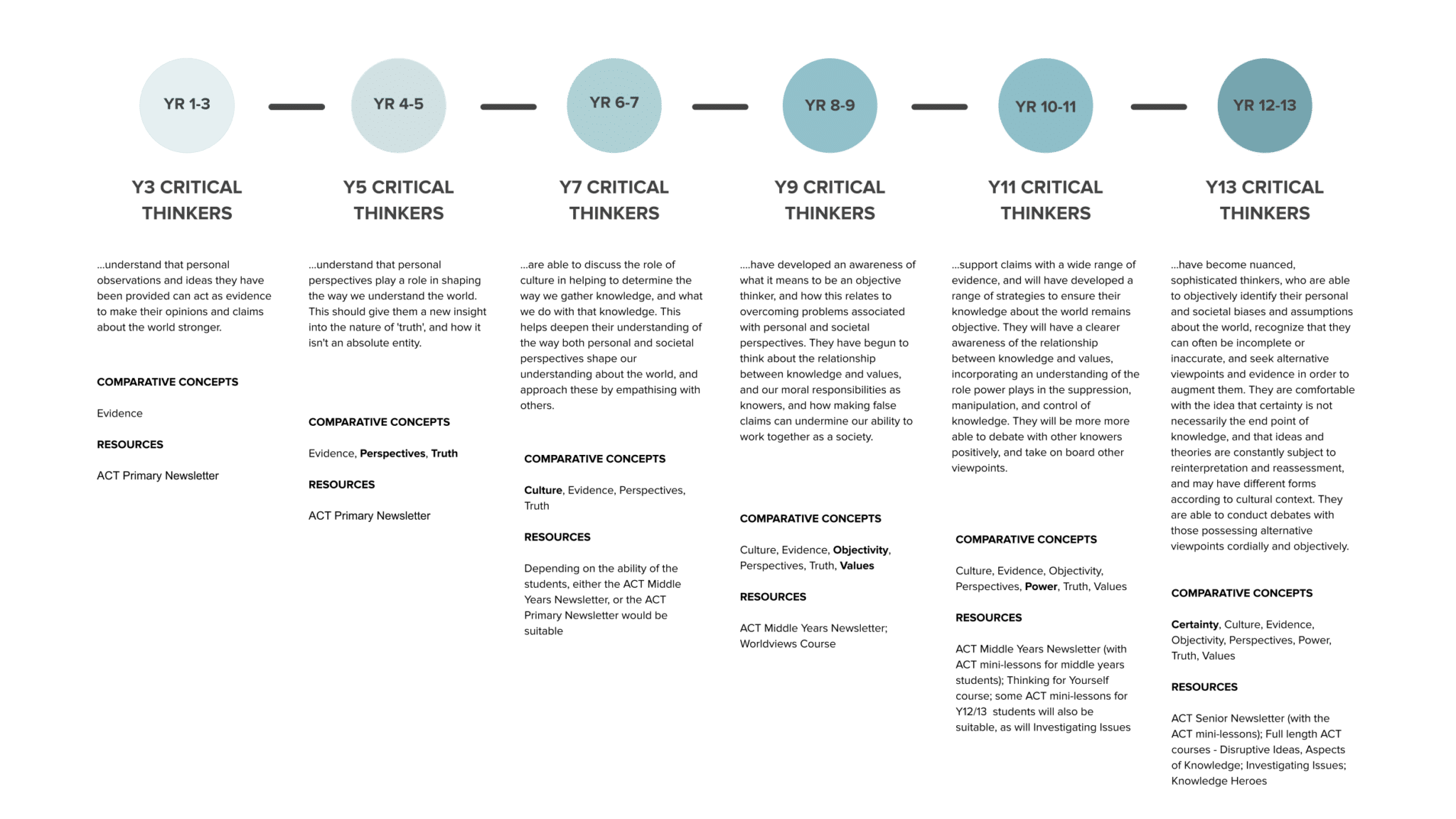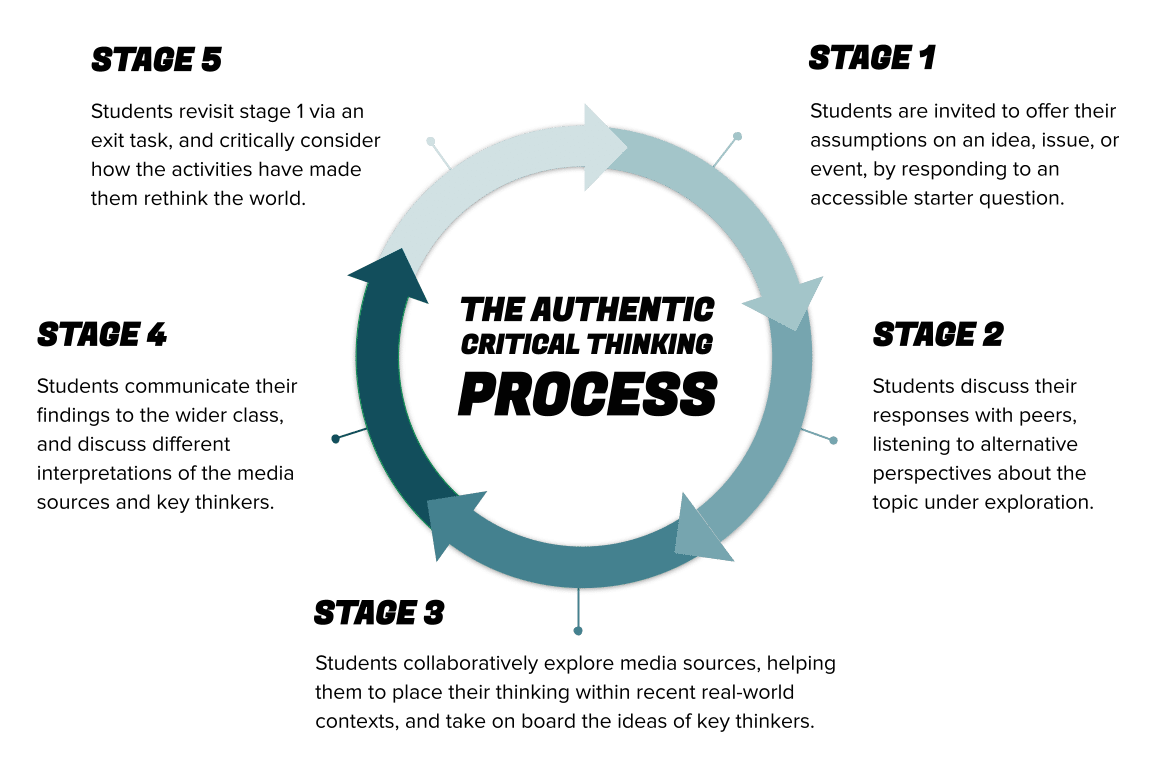Our manifesto: authentic critical thinking (ACT)
All our teaching and learning resources – whether they are for the TOK course, middle years students, primary learners, or those following a different programme – are based on fostering authentic critical thinking (ACT).
Understanding what this means will enable you to become a more focused teacher, integrate the course with the rest of the learning in your school, and turn your students into nuanced, open-minded, and courageous thinkers.
1 Critical thinking requires a clear, measurable, practicable definition. Here’s ours:
Authentic critical thinking means to confront – rather than confirm – your biases and assumptions about the world.
Our key aim for the TOK course is to help students to become effective critical thinkers. But there are many different ways to define what critical thinking is, and this variation brings with it two problems: first, it leads to a lack of consensus amongst educators in terms of what critical thinking looks like in the classroom, and how schools should promote it; second, it causes a lack of clarity for students, making it hard for them to evaluate their cognitive progress in terms of becoming effective critical thinkers.
Critical thinking is also better understood as being a more personal process than is sometimes understood, because before we can begin to identify how others try to mislead us, we must establish how we mislead ourselves. We need, in short, to leave our echo chambers – and we have to decide to do that for ourselves. Finally, we believe the best context for developing critical thinking is within the contemporary, real-world – which is why we term it authentic critical thinking (ACT).
2 ACT forms a continuum of learning
As soon as you make ACT your central learning aim, it becomes much easier to conceive of your role as an educator – whether you’re teaching TOK, another DP subject, or a GCSE, A-level, AP, or other course – as being part of a much bigger, more integrated picture.
ACT enables you to link the learning going on in your classroom to the rest of your school, both vertically (by age) and horizontally (by subject), turning it into a much more meaningful and effective intellectual endeavour.
The continuum begins in primary school, is consolidated in middle years, and is deepened during senior years (either for TOK students, or for those involved in a different educational programme). This journey is indicated above, together with some of our support for it.
The downloadable infographic below outlines the cognitive aims of the ACT continuum, using the comparative concepts as a conceptual scaffold (students culminating high-school with TOK use the 12 key concepts).
3 ACT takes place in the contemporary, real world
The single most important measure of an education’s credibility is the extent to which it can be applied to the real world. With this in mind, our resources are designed to ensure that learning is applied to the very latest events, issues, and developments going on around the globe.
Our courses for TOK, our middle and senior newsletters, the mini lessons, the Thinking For Yourself course, Investigating Issues, 12 Key Concepts; all of these (and more) are updated every month, and linked to contemporary events, meaning they are always relevant and engaging.
4 ACT should be easily deployable in any academic subject
Authentic critical thinking should not be the preserve of specialized, specifically-trained teachers. It should be accessible to any teacher who is trying to encourage their students to look beyond the headlines, and apply an epistemological eye to their subject.
ACT is more about rethinking what we already know, rather than teaching much new material. It’s about encouraging students to question what they’ve been taught, compare and contrast different forms of knowledge, and consider how it’s used.
ACT is therefore not ‘taught’ as such; rather, students are presented with the structure in which to carry out the learning themselves, as indicated in the downloadable diagram.
5 ACT aligns closely to the 4Cs
Academic, political, business, and scientific leaders have for a long time identified ‘4Cs’ – critical thinking, collaboration, communication, and creativity – as being the essential skills to develop in order to successfully navigate the online and real world, and become successful.
Unfortunately, most education systems oppose the 4cs. Rigid curriculums prefer students not to think creatively; public exams hone competition rather than collaboration, a narrow range of communication skills are required for the majority of assessment tasks, and few rubrics reward critical thinking. The fallacy of tradition applies: we’ve always done it like this, so we’ll continue doing it in the same way.
In contrast, encouraging students to approach the world via ACT means that they will naturally take on board and apply the 4Cs as they develop as learners. They’ll learn to collaborate with others as they share and discuss ideas, they’ll develop their powers of communication in order to articulate ideas, by challenging the way we traditionally view the world, they’ll understand the value of creative thinking, and as they support their ideas with evidence and examples, and demand that others do the same, the more effective they’ll become as critical thinking.
In fact, the more your students apply ACT in the classroom, the more they will blend all the 4Cs into one seamless cognitive process.
6 ACT is a perfect launchpad for a range of different final products
Whilst a lot of schools claim to (and undoubtedly do) promote critical thinking, it’s important that whether this occurs via stand-alone classes, or within other subject classes, it leads to a demonstrable final product. For students studying TOK, this is no problem: the course culminates in an essay and an exhibition. For other students, the evidence that they have carried out critical thinking is far more nebulous.
Viewing ACT as a pathway (indicated above) towards a final product gives it more purpose, adds structure, and makes activities more accountable.
It will also provide students with the means to clearly showcase their abilities as nuanced, sophisticated thinkers.
Whether it’s an HPQ, EPQ, Global Perspectives report, TOK essay, TOK exhibition, or University Entrance Portfolio, our resources support students highly effectively as they create these final products. They introduce students to big ideas and key thinkers, and help them to apply concepts and skills to real-world events and issues, all of which provides the perfect launch pad to create a project-based assignment.
7 ACT strengthens the university profile of any student
University entrance has never been more competitive, so many schools are looking to augment their student transcripts so that they showcase a wider range of skills and interests. Being a genuine authentic critical thinker, which as we’ve said above, incorporates the widely fêted ‘4Cs’, gives students a significant advantage when they write their personal statement, and, where relevant, attend application interviews.
Students can refer extensively to the ideas and thinkers that they’ve encountered during an ACT course, demonstrate how their learning is relevant to the latest events and issues going on around the world, and provide tangible evidence that they’ve become impressive knowers via the final product that they create – whether it’s a TOK essay or exhibition, an HPQ or EPQ, or a University Entrance portfolio.
8 ACT creates lifelong learners
Finally, ACT should be seen not only as the means to help students become better thinkers at school, but as a way to ensure that they will become life-long members of the epistemic community, and continue to seek new ways of understanding throughout their lives.
We support students to leave their echo chambers, and become curious, open-minded knowers of the world, who will always be willing to take on board new ideas, augment their understanding, and be receptive to different cultural perspectives.

Deploy ACT in your school: become a member!
Members have access to a huge range of classroom-ready resources, including three different TOK Courses, the monthly TOK Mini-Lessons, our TOK Padlets, the Integration Tool, TOK Filmography, and our dedicated resources for ACT.
Join in seconds here, and turn your school into a hub of authentic critical thinking.




